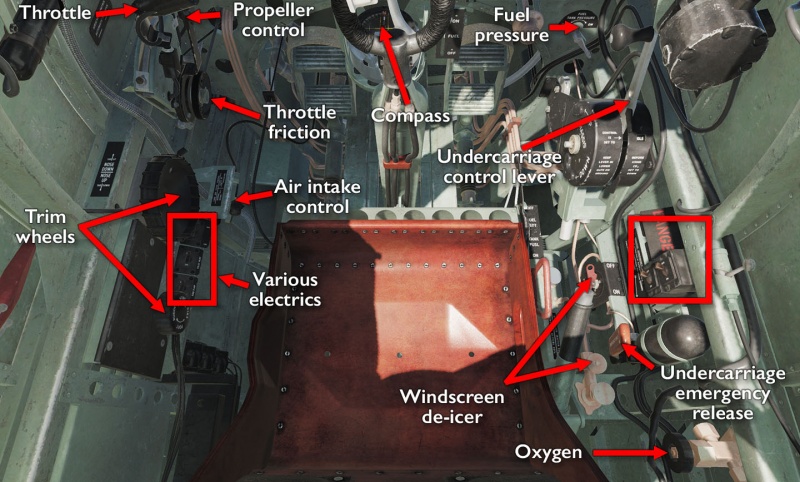Spitfire L.F. Mk. IX: Difference between revisions
mNo edit summary |
mNo edit summary |
||
| Line 1: | Line 1: | ||
{{RightImg| | {{RightImg|File:DCS_Spitfire_Mk.IX_700x1000.jpg}} | ||
[[File:Spitfire icon.png|frameless|left]] | [[File:Spitfire icon.png|frameless|left]] | ||
Revision as of 17:03, 11 July 2020
It's the Spitfire. Does anything more really need to be said? The LF Mk IX variant available in DCS World is a mid-war model introduced, along with other “late-Merlin engine” variants, to counter the new threat of the Fw 190 and to be more adept at high-altitude interception of Ju 86 bombers.
Features
The Spitfire L.F. (Low-altitude Fighter) Mk. IX as represented in DCS comes with:
- A very messy cockpit.
- A very narrow landing gear that tends to make landings even messier than the cockpit.
- A differential braking system that makes controlling it on the ground messier still.
- Elevator and (more importantly) rudder trimming to make straight and level flights (and landings) possible.
- A later-model Mk II collimator gun sight.
- 4× 7.69mm Browning machine guns and 2× 20mm Hispano Mk. II cannons.
- The option to use clipped-wing variants for better roll and low-level speed at the cost of reduced wing lift and turn speed.
- An injection carburettor that, unlike earlier models, was not (quite as) susceptible to sputtering to a halt during negative-g and inverted flight.
Flying the pitfire L.F. Mk. IX
Flying the Spitfire is a schizophrenic experience. In the air, it is nothing short of wonderful, missing aileron trim aside. It has no adverse yaw to speak of; it turns on a dime; it booms and zooms with the best of them; and it sprays bullets all over the countryside. The problem is getting up there, and getting down again.
Any time the Spitfire is in contact with the ground, however, is an absolute misery. Its sensitive differential braking system makes it difficult to keep it straight, and its narrow landing gear means that any kind of swinging about is rather likely to end in the airplane tipping over and scraping the wings. Landings, in particular, need a lot of care to not end up the same: an unbalanced or slightly crabbed aircraft that produces rolling forces that pushes the airframe over its tipping point — a situation made worse by how few options the pilot has to fix it at that point without unbalancing everything even further.
Really, the trick is, after all the fun and silly flailing about the plane allows you to enjoy in the air, to be able to settle down and do everything very carefully, slowly, and methodically to ensure your outing does not end upside down and on fire.
Cockpit overview
Getting into the air
The Spitfire is one of the oldest aircraft available in DCS, and this is made evident by how many steps you have to go through to get it into the air, even though it is not actually all that complex an aircraft. It relies entirely on mechanical operations, without any automation or other pilot aid. Like all full-sim aircraft, it has the RWinHome “cheat” keyboard shortcut that runs through the startup process for you, and the manual and Chuck's guide, linked below describe it in full.
The short version of it all is:
- Check that everything is off so you do not shock or overburden the system during start-up.
- Close the cockpit and check and set up altimeter, flaps, landing gear, and brakes.
- Set the propeller RPM and throttle to their starting positions (fully forward and just forward of idle, respectively).
- Open the carburettor and primer valve.
- Waggle the pump handle a bunch to prime the engine.
- Turn magnetos, boosters, and starter coils on.
- Hold the starter and booster buttons to rotate the engine, and move the mixture control lever fully forward to have a spark catch the engine.
- Throttle back to not brake anything and secure the starter equipment.
- Turn everything else on while idling the engine at ~1100 RPM to warm it up.
- Make your way to the runway (good luck) and take off (this is actually reasonably easy compared to the rest).
Shooting something
Flying and shooting is what the Spitfire is made to do, so obviously, this is much easier to get going than actually getting the thing in the air to begin with:
- Turn the sight on (a switch to the left of the sight).
- Set the wingspan of the expected target (35' or so for your average Bf 109 or Fw 190).
- Set range to 300 yards (for best gun convergence).
- Get the target wings to fit inside the gunsight cross.
- Safety off; fire.
Now enjoy your well-earned cyber ace status.
Links and files
- Vehicle Size Chart for sight adjustments.
- Chuck's Spitfire LF Mk IX guide at Mudspike.
- DCS: Spitfire LF Mk. IX in the DCS shop.
Related DCS modules
- Spitfire IX The Big Show Campaign by Reflected Simulations.
- Spitfire LF Mk. IX Operation Epsom Campaign by B&W Campaigns (and Bunyap).
More information
- Supermarine Spitfire on wikpedia.
- Bunyap's Four Months in the Life of a Spitfire IX Wing video series.
- Taming taildraggers — an essay, Part 1, Part 2, and Part 3.






